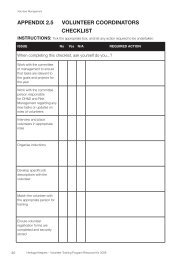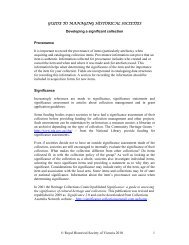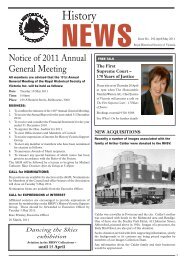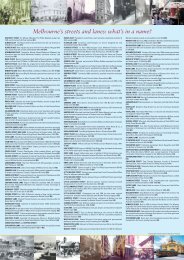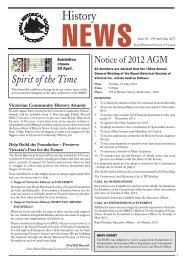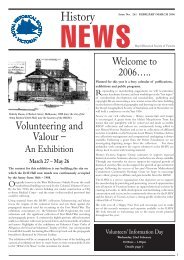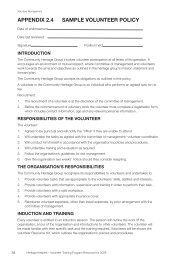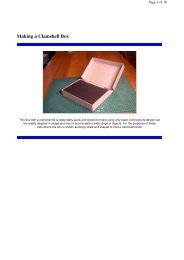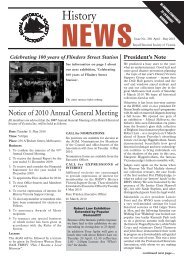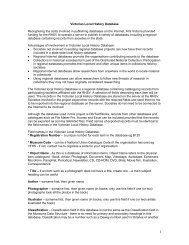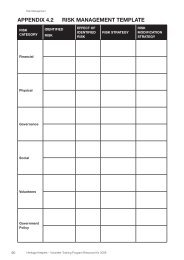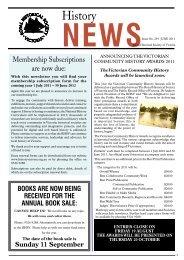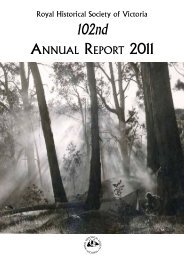Style guides for local history publishing - Royal Historical Society of ...
Style guides for local history publishing - Royal Historical Society of ...
Style guides for local history publishing - Royal Historical Society of ...
Create successful ePaper yourself
Turn your PDF publications into a flip-book with our unique Google optimized e-Paper software.
GUIDE TO MANAGING HISTORICAL SOCIETIESInvolving People<strong>Style</strong> <strong>guides</strong> <strong>for</strong> <strong>local</strong> <strong>history</strong> <strong>publishing</strong>(Paper presented by Vicki Court at the History Victoria Support Group Seminar Dayat Moe in March 2010)Part <strong>of</strong> the role <strong>of</strong> historical societies to make the in<strong>for</strong>mation held in collectionsavailable to the public. One way <strong>of</strong> doing this is to publish books and magazinearticles.Un<strong>for</strong>tunately not all authors write well.In his book How to do <strong>local</strong> <strong>history</strong>, Gavin McLean describes his experience <strong>of</strong>reviewing a two volume <strong>history</strong> <strong>of</strong> a city –The books were heavy, the prose heavier. Had every hard-won historical nugget theauthor unearthed been shoehorned into these paper bricks? It seemed so. It wasclassic ‘one damn thing after another’ <strong>history</strong>, an impenetrable thicket <strong>of</strong> facts thathad overgrown and strangled the life out <strong>of</strong> the story – and my interest.McLean then describes later visiting, with a friend, the city about which the book waswritten –We went to the library <strong>for</strong> some in<strong>for</strong>mation about the <strong>history</strong> <strong>of</strong> a <strong>local</strong> attraction. ‘Isit in the twin tubby?’ one librarian asked a colleague. ‘Perhaps’, came the vague reply– she never used them because she found them almost impenetrable. iWhen writing, it is important to know your audience. A good writer researches thesubject thoroughly and then sorts the in<strong>for</strong>mation be<strong>for</strong>e selecting the facts to include.Choosing what to leave out <strong>of</strong> the final project can be a challenge. As well asin<strong>for</strong>ming the readers, the author also needs to capture and keep their interest. Factsare important but McLean stresses that readers ‘want and deserve stories that areimaginatively written and attractively written’. ii There is no point in writing a book,no matter how well it has been researched, that no one is going to read.A number <strong>of</strong> books on writing, including writing <strong>history</strong>, are available in libraries andbookshops. These books provide in<strong>for</strong>mation on how to research, write clearlyincluding the use <strong>of</strong> grammar, spelling and punctuation plus in<strong>for</strong>mation on designingand producing the publication.A recent Australian publication on this topic is How to write <strong>history</strong> that people wantto read by Ann Curthoys and Ann McGrath.Another useful tool <strong>for</strong> authors is <strong>Style</strong> manual <strong>for</strong> authors, editors and printers. Thesixth edition was published in 2002.In 2006 the Federation <strong>of</strong> Australian <strong>Historical</strong> Societies Inc. published Publishing<strong>history</strong>: a guide <strong>for</strong> historical societies written by Helen Doyle and Katya Johanson.© <strong>Royal</strong> <strong>Historical</strong> <strong>Society</strong> <strong>of</strong> Victoria 2010 1
Researching and collecting the in<strong>for</strong>mation and presenting the facts in an interestingmanner is the first step in producing a book or an article, but that is only part <strong>of</strong> theproject. The style in which the in<strong>for</strong>mation is presented is also important. As well asassisting with the layout <strong>of</strong> documents style <strong>guides</strong> provide in<strong>for</strong>mation about usingother important elements <strong>of</strong> the publication such as citations and bibliographies and,in some cases, indexes.<strong>Style</strong> <strong>guides</strong>The editors <strong>of</strong> most <strong>publishing</strong> houses and journals stipulate the style guidelines to befollowed. For example the editors <strong>of</strong> the Victorian <strong>Historical</strong> Journal provide thefollowing in<strong>for</strong>mation concerning guidelines <strong>for</strong> their publication.Where not otherwise indicated, the Journal follows the style set down in the <strong>Style</strong>Manual <strong>for</strong> Authors, Editors and Printers, 6th ed., Milton, John Wiley & Sons, 2002.Spelling and hyphenation should follow the Macquarie Concise Dictionary, 6th ed.,Sydney, Macquarie Library, 2009. iiiIf a style guide is not stipulated <strong>for</strong> your publication then select one <strong>of</strong> therecommended styles <strong>for</strong> writing and always be consistent when citing sources andpreparing reference notes or bibliographies. <strong>Style</strong> <strong>guides</strong> used by Australian writersinclude –• Commonwealth <strong>of</strong> Australia. <strong>Style</strong> manual <strong>for</strong> authors, editors and printersrevised by Snooks & Co. 6 th ed., Milton, John Wiley & Sons, 2002.• Turabian, Kate L. A manual <strong>for</strong> writers <strong>of</strong> term papers, theses and dissertations.7 th ed. Chicago, University <strong>of</strong> Chicago Press, 2007Both <strong>of</strong> these publications have been updated to include working with electronicpublications.CitationsReaders <strong>of</strong> non-fiction frequently check the footnotes or endnotes and the referencelist or bibliography <strong>for</strong> other material that may be useful <strong>for</strong> further research on thetopic. Quotes provided in books and articles are <strong>of</strong>ten partial quotes and the readermay wish to read the full item from which the quotation was taken. The author mayalso allude to further in<strong>for</strong>mation on a topic available in a newspaper article or othersource and the citation can direct the reader to that source.To cite is to ‘quote (a passage, book or author) in support <strong>of</strong> an argument etc’. ivCitations are used when quotations from other works are included in the writing andwhen reference is made to the ideas <strong>of</strong> another person.Using citations shows that the writer acknowledges the use <strong>of</strong> material <strong>of</strong> others andhas based the work on research. Citations can show how an idea became accepted.Using citations can also be useful when building an argument to demonstrate analternative viewpoint.However do not over use citations, especially in a work <strong>for</strong> a general audience.© <strong>Royal</strong> <strong>Historical</strong> <strong>Society</strong> <strong>of</strong> Victoria 2010 2
Footnotes, endnotes or reference listsAs well as citing the work and ideas <strong>of</strong> others, the use <strong>of</strong> footnotes or endnotes allowsthe writer to provide additional short items <strong>of</strong> in<strong>for</strong>mation that, if included, wouldhinder the train <strong>of</strong> thought in the main work but which may be relevant to the topic.Unless a publisher stipulates a style guide the author needs to choose a style <strong>for</strong>footnotes, endnotes or reference lists and be consistent in using that style.If there are many citations, endnotes or reference lists (citations grouped at the end <strong>of</strong>the article / chapter or publication) are usually used. If there are only a few citations,footnotes may be used. Having the footnotes on the same page allows the reader tocheck the footnotes as the article is read.Word processing programs include the ability to insert footnotes or endnotes in adocument. In Micros<strong>of</strong>t Word 2003 use the Insert menu to locate the Footnote boxafter placing the cursor at the end <strong>of</strong> the word where the indicator (usually a number)<strong>for</strong> the footnote or endnote is to be placed.Note the following example:We went to the library <strong>for</strong> some in<strong>for</strong>mation about the <strong>history</strong> <strong>of</strong> a <strong>local</strong> attraction. ‘Isit in the twin tubby?’ one librarian asked a colleague. ‘Perhaps’, came the vague reply– she never used them because she found them almost impenetrable. vPlace the cursor after impenetrable and thengo to the Insert menu and select Footnote.Select either Footnote or EndnoteThe Options button allows the choice <strong>of</strong>style <strong>of</strong> numberingClick the OK button.In this case the next number <strong>for</strong> an endnote –number 5 – is added after the quotation and anumber 5 is added to the list <strong>of</strong> endnotes <strong>for</strong>in<strong>for</strong>mation relating to the citation to beadded.Chapter 12 <strong>of</strong> <strong>Style</strong> manual <strong>for</strong> authors, editors and printers (2002) provides details<strong>for</strong> methods <strong>of</strong> citation <strong>for</strong> different <strong>for</strong>ms <strong>of</strong> publications. Three systems are provided– the Author-Date system (AD), Documentary-Note system (DN) and the Vancouversystem (V).Examples <strong>for</strong> books:• Curthoys, A & McGrath, A, 2009, How to write <strong>history</strong> that people want to read,University <strong>of</strong> New South Wales Press, Sydney (AD)• A Curthoys & A McGrath, How to write <strong>history</strong> that people want to read,University <strong>of</strong> New South Wales Press, Sydney, 2009 (DN)• Curthoys A, McGrath A. How to write <strong>history</strong> that people want to read. Sydney:University <strong>of</strong> New South Wales Press, 2009 (V)© <strong>Royal</strong> <strong>Historical</strong> <strong>Society</strong> <strong>of</strong> Victoria 2010 3
Examples <strong>for</strong> articles:• J McCulloch, ‘Why frontier Queensland beat urbane Victoria to Women’sSuffrage’, Victorian <strong>Historical</strong> Journal, vol. 79, no. 2, 2008, pp 237-50 (AD)• McCulloch, D 2008, ‘Why frontier Queensland beat urbane Victoria to Women’sSuffrage’, Victorian <strong>Historical</strong> Journal, vol. 79, no. 2, pp 237-50 (DN)• McCulloch J. Why frontier Queensland beat urbane Victoria to Women’sSuffrage. Victorian <strong>Historical</strong> Journal 2008; 79(2): 237-50 (V)*Note: in the above examples initials were used instead <strong>of</strong> given names but full namescan be used.*Vancouver style does not use italics <strong>for</strong> titles <strong>of</strong> publications or quotation marks <strong>for</strong>titles <strong>of</strong> articles.Basically the in<strong>for</strong>mation used when items are cited include:Author(s) name(s)Title <strong>of</strong> article if applicableTitle <strong>of</strong> publicationPlace <strong>of</strong> publicationPublisher**Date (usually year)Edition statement (if applicable)Page numbers (if applicable)**A publisher is ‘a person or esp. a company that produces and distributes copies <strong>of</strong> abook, newspaper, etc. <strong>for</strong> sale’. A printer is ‘a person who prints books, magazines,advertising matter, etc’. vi The name <strong>of</strong> the publisher will normally be located on thetitle page or the reverse <strong>of</strong> the title page or occasionally listed at the back <strong>of</strong> the book.Some books also list the printer but the printer is not the publisher. In some cases theauthor may be the publisher if the book is self-published.ManuscriptsProvide the name <strong>of</strong> the author, title and date (where available) plus the name <strong>of</strong> thecollection where the manuscript is held when citing a manuscript.Example:• Milbourne, Margaret, The story <strong>of</strong> the life <strong>of</strong> Margaret Ellen Milbourne <strong>of</strong>Warracknabeal and Ballarat, notes compiled from her diaries in 1982, <strong>Royal</strong><strong>Historical</strong> <strong>Society</strong> <strong>of</strong> Victoria manuscript collection, Box 152-15, MS 000663• McLean, D C, The Colac-Alvie Railway, 1974, <strong>Royal</strong> <strong>Historical</strong> <strong>Society</strong> <strong>of</strong>Victoria manuscript collection, Box 272-17, MS 001629Websites and electronic documentsGenerally in<strong>for</strong>mation identifying the website or electronic document is provided as<strong>for</strong> a paper based item followed by the date that the source was viewed and the url <strong>for</strong>the source in diamond brackets.Example:• <strong>Royal</strong> <strong>Historical</strong> <strong>Society</strong> <strong>of</strong> Victoria, viewed 10 March 2010,• Guidelines <strong>for</strong> contributors <strong>of</strong> the Victorian <strong>Historical</strong> Journal, viewed 10 March2010 © <strong>Royal</strong> <strong>Historical</strong> <strong>Society</strong> <strong>of</strong> Victoria 2010 4
Abbreviations used in citation listsAbbreviations may be used to avoid repeating all the details again when a work iscited in a list more than once.ibid signifies reference to a previous work cited immediately be<strong>for</strong>e the new entryExample:1 McLean, Gavin. How to do <strong>local</strong> <strong>history</strong>. Dunedin: Otago University Press, 2007 p582 ibid, p57op.cit. refers the reader to a previously cited work8 McLean, Gavin. op.cit., p203Be careful if using ibid in footnotes until the complete article has been written as theplacement <strong>of</strong> footnotes can change if new text is inserted.In-text citationsCitations can also be used within the text instead <strong>of</strong> using footnotes, especially whenthere are only a few citations in the document.The name <strong>of</strong> the author, date and possibly page number can be provided in roundbrackets at the end <strong>of</strong> a sentence).Example:(McLean, 2006, p103)When the name <strong>of</strong> the author is mentioned within the sentence, only the date and pagenumbers, if required need to be included in the round brackets.Full details <strong>of</strong> the publication would need to be provided in a bibliography or list <strong>of</strong>further reading.BibliographiesA bibliography can be a list <strong>of</strong> books, articles and other material referred to by anauthor in a publication. A bibliography may also include other source material on thesubject that may be <strong>of</strong> interest to a reader.Bibliographies are alphabetical lists arranged by the name <strong>of</strong> the author and there<strong>for</strong>ethe surname always comes first followed by the given name or initial(s). The style <strong>of</strong>the rest <strong>of</strong> the in<strong>for</strong>mation in a bibliography follows the <strong>for</strong>mat <strong>of</strong> material in areference list.Bibliographies may also contain annotations, providing a brief summary <strong>of</strong> thecontent <strong>of</strong> an item or highlighting a section <strong>of</strong> the item that may be particularlyrelevant to the topic.Bibliographies may be one long list <strong>of</strong> items or a bibliography may consist <strong>of</strong> severalshorter lists divided by topic or types <strong>of</strong> publications. There may be a list <strong>of</strong> books onthe topic followed by a list <strong>of</strong> articles.When a bibliography provides a list <strong>of</strong> material not necessarily directly referred to inthe book it may be entitled ‘Further reading’.© <strong>Royal</strong> <strong>Historical</strong> <strong>Society</strong> <strong>of</strong> Victoria 2010 5
Indexes• Chapter 15 <strong>of</strong> <strong>Style</strong> manual <strong>for</strong> author’s writers and printers provides usefulin<strong>for</strong>mation about indexing publications.• Australian and New Zealand <strong>Society</strong> <strong>of</strong> Indexers website provides many articles and hints <strong>for</strong> indexingprojects. ANZSI also run workshops on indexing.• John Adams, <strong>for</strong> many years has run indexing workshops at the RHSV and hisguide, Indexing <strong>for</strong> historical societies, can be purchased from the RHSV.Indexes are an important component <strong>of</strong> books providing a valuable aid <strong>for</strong> researchersto locate in<strong>for</strong>mation about the names <strong>of</strong> people, places, organisations and concepts orgeneric terms.Be<strong>for</strong>e indexing a publication it is essential that the indexer reads the publication to beindexed, preferably twice, to gain an understanding <strong>of</strong> the text and to start <strong>for</strong>mulatinga list <strong>of</strong> the major terms <strong>for</strong> the index.The main indexing element is called an entry.Each entry has a main headingSome entries may also have sub-headings providing additional levels <strong>for</strong> searching.References need to be made to all significant in<strong>for</strong>mation in the text.Choose the best term (heading) to describe the in<strong>for</strong>mation.Attach any further terms that provide additional detail.It is not necessary to index every item.The page numbers <strong>for</strong> where the in<strong>for</strong>mation can be found is then provided.Indexes are arranged alphabetically.Examples: (from the index <strong>of</strong> the book Kapital by Kristen Otto, 2009)Tait family 66-8Taylor, Squizzy 314-16Waroutbreak 151-8enlisting 156-7Creating the indexWord processing programsIndexes can be created manually in word processing programs.Create the list <strong>of</strong> terms and then add the page numbers, interfiling any additionalterms as required.Many word processing programs also have a feature <strong>for</strong> creating an index.In Word 2003• Select the text to be indexed• Go to the Insert menu• Select Index and Tables© <strong>Royal</strong> <strong>Historical</strong> <strong>Society</strong> <strong>of</strong> Victoria 2010 6
• Select the options requiredIt is possible to use a different term instead <strong>of</strong> the selected word.Detailed in<strong>for</strong>mation about doing this is supplied in Help. Search <strong>for</strong> Index in theIndex list <strong>for</strong> details.DatabasesDatabases can also be used <strong>for</strong> some indexing projects.• Create a data structure with a field <strong>for</strong> terms and a field <strong>for</strong> pages.• Create a report <strong>for</strong>m <strong>for</strong> the presentation <strong>of</strong> the in<strong>for</strong>mation.• Use the write the report to file feature to produce the index list.Indexing programsThere are a number <strong>of</strong> computer programs designed <strong>for</strong> indexing including:CINDEXMACREXSky IndexIt is important to remember that the s<strong>of</strong>tware does not index the document. Theindexer still needs to select the terms required <strong>for</strong> the index.When indexing, the indexer may choose a term to describe a concept although theauthor may not have specifically used that term.It is important to remember that the reason <strong>for</strong> indexing the publication is to help thereader to quickly locate required in<strong>for</strong>mation.i McLean, Gavin. How to do <strong>local</strong> <strong>history</strong>. Dunedin: Otago University Press, 2007 p58ii ibid, p57iii Guidelines <strong>for</strong> contributors <strong>of</strong> the Victorian <strong>Historical</strong> Journaliv Concise Ox<strong>for</strong>d dictionary <strong>of</strong> current English usage. 8 th ed. Ox<strong>for</strong>d: Clarendon Press, 1990v McLean, Gavin. op.cit. p58vi Concise Ox<strong>for</strong>d dictionary <strong>of</strong> current English usage. 8 th ed. Ox<strong>for</strong>d: Clarendon Press, 1990© <strong>Royal</strong> <strong>Historical</strong> <strong>Society</strong> <strong>of</strong> Victoria 2010 7



